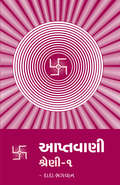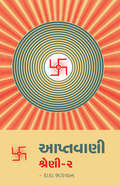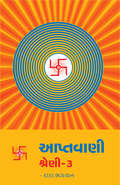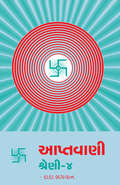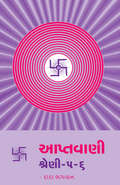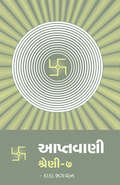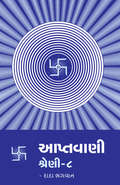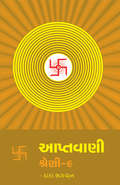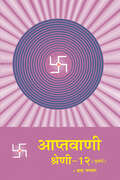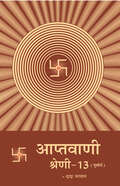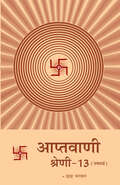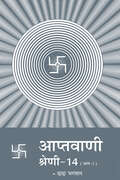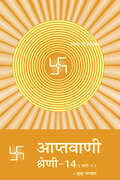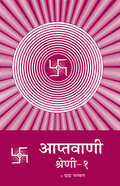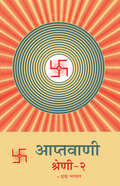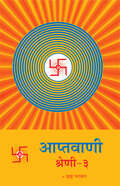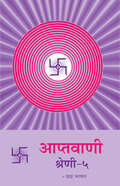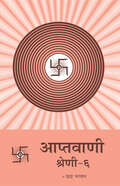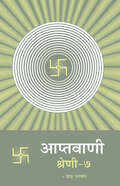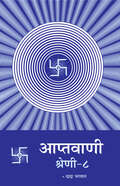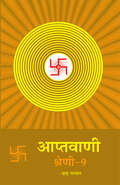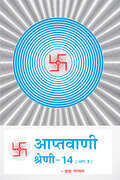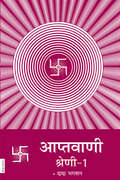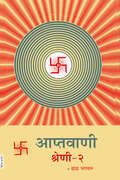- Table View
- List View
Aptavani Part 1: આપ્તવાણી - ૧
by Dada Bhagwanજગત કોણે બનાવ્યું? શું આ જગત તમારા માટે એક કોયડો છે? આ બધું કેમ ચાલે છે તેનું તમને આશ્ચર્ય થાય છે? આપણો આત્મા કેમ અનંત કાળથી ભટક્યા કરે છે? કર્તા કોણ છે? ધર્મ શું છે? મુક્તિ શું છે? ધર્મ કરતાં અધ્યાત્મ કઈ રીતે અલગ છે? શુદ્ધાત્મા શું છે? મન, વચન અને કાયાના કાર્યો શા છે? સંસારી સંબંધો કેવીરીતે સાચવવા? પ્રારબ્ધ અને પુરુષાર્થના ફરકને કેવીરીતે ઓળખાવો? અહંકાર શું છે? ક્રોધ, માન, માયા, લોભનું કારણ શું છે? જેને મુક્તિ વિષે જિજ્ઞાસા છે, અથવા જેને મુક્તિ જોઈએ છે તેને જીવનમાં આવા ઘણા બધા સવાલો અને કોયડાઓ હશે. આત્માનું જ્ઞાન એ, બધાનો અંતિમ ધ્યેય છે. આત્માના જ્ઞાન વિના મુક્તિ નથી. આ જ્ઞાન જ્ઞાનીના હ્રદયમાં છે. પરમ પૂજ્ય દાદાશ્રીના હ્રદય માંથી સીધા આવેલા આ જ્ઞાનનું અને જુદા જુદા કોયડાઓના જવાબોનું આ પુસ્તકમાં સંકલન કરવામાં આવ્યું છે. જ્ઞાનનું આ પવિત્ર પુસ્તક મુખ્યત્વે જેમનું વૈજ્ઞાનિક મન છે, જેઓ સંસારિક જીવનના ભોગવટાથી મુક્ત આત્માની શાંતિનું શરણું શોધે છે, તેમને માટે છે.
Aptavani Part 2: આપ્તવાણી - ૨
by Dada Bhagwanમોક્ષનો રસ્તો બધા માટે ખુલ્લો છે. તેને શોધવાની જરૂર છે. ‘જેને છૂટવું છે તેને કોઈ બાંધી શકતું નથી અને જેને બંધાવું છે તેને કોઈ છોડાવી શકતું નથી’.—પરમ પૂજ્ય દાદાશ્રી પોતે શેનાથી બંધાયો છે? પોતે અજ્ઞાનથી બંધાયો છે અને જ્ઞાન ( આત્મજ્ઞાન )થી મુક્તિ મેળવી શકે છે. બધા બંધનોનું મૂળ કારણ અજ્ઞાન છે. આ પુસ્તકમાં પરમ પૂજ્ય દાદાશ્રીના આધ્યાત્મિક વિચારો વૈજ્ઞાનિક દ્રષ્ટિએ, સાદી અને સરળ રીતે ચર્ચવામાં આવ્યા છે. તેમણે આ જગતની વાસ્તવિકતા, સાંસારિક મોહ અને તેના પરિણામો, ધર્મના પ્રકાર (રીયલ અને રીલેટીવ ધર્મો ), તપના પ્રકાર ( આંતર અને બાહ્ય તપ ), યોગના પ્રકાર (જ્ઞાન અને અજ્ઞાન યોગ ), સંજોગોના પ્રકાર ( સ્થૂળ અને સુક્ષ્મ ), મન, બુદ્ધિ, ચિત્ત અને અહંકારના કાર્યોની ચર્ચા કરી છે. પરમ પૂજ્ય દાદાશ્રીનું આવું જ્ઞાન વાચકને અજ્ઞાન દૂર કરી, મુક્તિના પંથે આગળ વધવામાં મદદ કરશે. આ જ્ઞાનનું પુસ્તક એ કોઈ ધર્મનું પુસ્તક નથી; એ વ્યવહારુ આધ્યાત્મ વિજ્ઞાનનું પુસ્તક છે. તે આધ્યાત્મ ઇચ્છુક(મુમુક્ષુઓ), દાર્શનિકો, વિચારકો, અને ખરેખરા શોધકને અત્યંત ઉપયોગી છે.
Aptavani Part 3: આપ્તવાણી - ૩
by Dada Bhagwanલોકોને જીવનમાં સંખ્યાબંધ ધ્યેયો અને મહત્વાકાંક્ષાઓ હોય છે. છતાંપણ, આપણામાંના મોટા ભાગના લોકો “ હું કોણ છું ?” સવાલનો જવાબ આપવામાં અસમર્થ છે. અનંતકાળથી લોકો જીવનમાં ભૌતિક ચીજો પાછળ પડેલા છે. છતાંપણ, એક ખરા જ્ઞાની પુરુષ આત્મસાક્ષાત્કારનો ખરો રસ્તો બતાવશે અને સંસારિક બંધનોથી મુક્ત થવામાં મદદ કરશે. આ પુસ્તકમાં, પરમ પૂજ્ય દાદાશ્રીએ આત્મા અને તેના ગુણધર્મો અને (આત્માના) પોતાના જ્ઞાન, દર્શન, શક્તિ, સુખ શું છે? સ્વસત્તા (બહારના સંજોગો પર આધારિત ન હોય) પરસત્તા ( બહારના સંજોગો પર આધારિત ) સ્વપરિણામ (રીલેટીવ સ્વરૂપના જ્ઞાતા દ્રષ્ટા ) અને પરપરિણામ (પોતાને કર્તા જાણીને), વ્યવહાર આત્મા અને નિશ્ચય આત્મા અને બીજા ઘણા મુદ્દાઓ પર ચર્ચા કરી છે. પુસ્તકના બીજા ભાગમાં, પરમ પૂજ્ય દાદાશ્રીએ અથડામણ વગર જીવન કેમ જીવવું, રાઇટ બિલીફથી કઈ રીતે દુઃખ નથી રહેતું, અને કુટુંબને લગતા મુદ્દાઓ, જેવા કે છોકરાઓ સાથેનો વ્યવહાર, સામાને સુધારવા કરતાં જાતે સુધરવું, એડજસ્ટમેન્ટ લેવા, રીલેટીવ બાબતમાં ઉપલક રહેવું, કુટુંબના સભ્યોને જુદા જુદા વ્યક્તિઓ સાથે, મહેમાનો સાથે, ઉપરીઓ સાથે, સંબંધોમાં સ્વાભાવિકતા રાખવી વગેરે માટે ચાવીઓ આપી છે. આ પુસ્તકનું વાંચન આપણા જીવનમાં પરમ આનંદ અને શાંતિ મેળવવામાં ઘણું ઉપયોગી થશે.
Aptavani Part 4: આપ્તવાણી - ૪
by Dada Bhagwanતમે આત્મા છો, અને આત્મા આખા વિશ્વનો પ્રકાશક છે. આત્મા તરીકે ‘પોતા’નામાં અનંત શક્તિ છે. અને છતાંપણ, બધી નિસહાયતા, દુઃખ, દર્દ, અસલામતી, ‘પોતે’ અનુભવે છે. આ કેટલું વિરોધાભાસી છે! એનું શું કારણ છે? ‘પોતાને’ ‘પોતાના’ સ્વરૂપ, શક્તિ, સત્તાનું ભાન નથી. એકવાર ‘પોતે’ જાગૃત થશ, તો આખા બ્રહ્માંડની માલિકીનું ભાન થશે. સામાન્ય રીતે જગત જેને જાગૃત કહે છે,તેને જ્ઞાનીઓ ઉંધે છે એમ કહે છે. આખું જગત ભાવ નિદ્રામાં પડ્યું છે. આ ભવમાં અને હવે પછીના ભવમાં શું ફાયદાકારક છે અને શું નુકશાનકારક છે તેની અજાગૃતિ; ક્રોધ, અહંકાર, કપટ, લોભ, મતભેદ, ચિંતા આ બધા ભાવ નિદ્રાને કારણે, સતત થયા કરે છે. “ હું જાગૃત છું” એ જાગૃતિ ફક્ત જડની છે. આત્મા તેનાથી સંપૂર્ણ જુદો છે. જે આત્માનું વિજ્ઞાન જાણે છે તે ભવચક્રથી મુક્ત થાય છે (જીવનમુક્ત). આ પ્રકાશનમાં પરમ પૂજ્ય દાદાશ્રીએ આત્મા જાગૃત કેમ કરવો, ધ્યાન, નિયતિ અને મુક્તિ, ધિક્કાર અને તિરસ્કાર, આત્માનો સંસારી ધર્મ, મુક્તિનો ધ્યેય, કર્મનું વિજ્ઞાન વગેરે વિષે પોતાનું જ્ઞાન ખુલ્લું કર્યું છે. જેઓ આત્માનો ખરો અર્થ શોધી રહ્યા છે તેમને આવું વાંચન જાગૃતિ વધારી અને મુક્તિના માર્ગે આગળ લઇ જશે.
Aptavani Part 5 and 6: આપ્તવાણી - ૫ અને ૬
by Dada Bhagwanજીવનના સામાન્યમાં સામાન્ય પ્રસંગોમાં કષાયો સૂક્ષ્મપણે કઈ રીતે કાર્ય કરી જાય છે, તેનો વિસ્ફોટ જો કોઈએ આ કળિકાળમાં કર્યો હોય તો એ એક આ 'અક્રમ વિજ્ઞાની' પરમકૃપાળુશ્રી દાદાશ્રીએ ! એમના થકી પ્રકટ થયેલા 'અક્રમ વિજ્ઞાન'માં આત્મા, અનાત્મા, આત્મા-અનાત્મા સંબંધિત જ્ઞાન તેમજ વિશ્વકર્તા, જગતનિયંતા જેવા જેવા ગુહ્ય વિજ્ઞાનોનું પ્રાકટ્ય તો છે જ, કિંતુ પ્રસ્તુત ગ્રંથમાં સર્વગ્રાહ્ય તેમ જ પ્રત્યક્ષ જીવનમાં અનુભવગમ્ય બની રહે તેવું ગુપ્ત વ્યવહાર-જ્ઞાન પ્રકાશમાન થાય તે લક્ષ લક્ષિત થયું છે. વાત્સલ્યમૂર્તિ પૂ. દાદાશ્રીની વાણી પ્રવચન, વ્યાખ્યાન કે ઉપદેશાત્મકપણે વહેતી નથી. જિજ્ઞાસુ, મુમુક્ષુ કે વિચારકોનાં હ્રદયમાંથી વાસ્તવિક જીવનપ્રશ્નોના સ્ફુરણનું સર્વ રીતે સમાધાનયુક્ત નીકળ તી 'ટેપ'માંનું 'વિજ્ઞાન' છે ! આપણામાંના મોટા ભાગનાં લોકો હમેશાં એક સમસ્યા નો સામનો કરી રહ્યા છે; જેમાં એકબાજુ સાંસારિક વ્યવહારમાં દરેક ક્ષણે બહારના પ્રશ્નો ઉભા હોય છે અને બીજીબાજુ આંતરિક સંઘર્ષો માં સપડાયેલા હોઈએ છીએ અને તે એકલે હાથે હલ કરવાના હોય છે. આપણે જોઈએ છીએ કે ક્યારેક આપણી વાણીએ પ્રશ્નો ઉભા કર્યા હોય છે, અથવા આપણને કોઈએ કશું કહ્યું તેથી આપણે દુઃખી થઈએ છીએ અથવા આપણે બીજાનું બુરું વિચારીએ છીએ અથવા આપણને લાગે છે કે આપણી સાથે અન્યાય થયો છે અથવા આપણે પોતે અંદરથી શાંતિ નથી અનુભવતા. સંસારિક જીવન નો વ્યવહાર એ સમસ્યાઓનું સંગ્રહસ્થાન છે. એક સમસ્યાનો નિવેડો આવે કે પાછળ બીજી ઉભી થાય છે. શા માટે આપણને આવી સમસ્યાઓનો સામનો કરવો પડે છે? શા માટે આપણે અનંત જન્મો થી ભટક્યા કરીએ છીએ? અટકણના કારણે! હકીકતમાં, પોતાની પાસે આત્મા નો પરમઆનંદ તો હતો જ, પરંતુ પોતે દૈહિક સુખોની અટકણમાં ડૂબી ગયો હતો. આ અટકણ જ્ઞાનીપુરુષની કૃપા થી અને ત્યારબાદ પોતાના પરાક્રમ થી તૂટી શકે. એક વખત તમને આત્મજ્ઞાન થશે, તો જગત શમી જશે. આ જગત બીજા ની વ્યર્થ ચર્ચામાં વેડફી નાખવા માટે નથી. આ જગત જેમ છે તેમ છે. તેમાં તમારે, ‘પોતા’ની, સેફ સાઈડ શોધવાની છે. તો ચાલો આપણે ડૂબકી લગાવીએ અને જાણીએ કે આ અક્રમ વિજ્ઞાન કઈ રીતે બંધન, કર્મો, વાણી, પ્રતિક્રમણ, કુદરત ના કાયદા, વગેરેનું વિજ્ઞાન સમજવામાં ઉપયોગી છે જેનાથી બધા સંસારિક સમસ્યાઓના વાવાઝોડા સામે ટકી રહેવું સરળ બને છે.
Aptavani Part 7: આપ્તવાણી - ૭
by Dada Bhagwanપ્રસ્તુત ગ્રંથ આપ્તવાણી ૭માં પરમ પૂજ્ય દાદાશ્રીની જીવનવ્યવહાર સંબંધી વાતચીત અને પ્રશ્નોત્તરી રૂપી વાણી નું સંકલન કરવામાં આવ્યું છે. જ્ઞાની પુરુષ જીવનના સામાન્યમાં સામાન્ય પ્રસંગોને પણ અસાધારણ દ્રષ્ટિ અને સમજણથી જુએ છે. આવા પ્રસંગો સુજ્ઞ વાચકને જીવનવ્યવહારમાં એક નવી જ દ્રષ્ટિ અને નવી જ વિચારશ્રેણી આપે છે. જે મુદ્દાઓ પર અહીં વર્ણન કરેલ છે તેમાંના કેટલાક આપણને વિચલિત કરી દે છે જેવા કે- જંજાળી જીવનમાં જાગૃતિ, લક્ષ્મીનું ચિંતવન , ગૂંચવાડામાં કેવીરીતે શાંતિપૂર્ણ રીતે રહી શકાય?, ટાળો કંટાળો, ચિંતાથી મુક્તિ, ભય પર કેવીરીતે વિજય મેળવવો?, કઢાપો-અજંપો, ફરિયાદો, જીવનની અંતિમ પળોમાં શું બને છે?, ક્રોધ કષાય, અતિ ગંભીર બિમારીમાં કેવીરીતે સમતા રાખવી?, પાપ-પુણ્યની પરિભાષા, ધંધા/ઓફીસમાં રોજબરોજની સમસ્યાઓનો અને આવી બીજી ઘણી જીવનમાં આવતી મુશ્કેલીઓનો કેવીરીતે નિકાલ કરવો. પ્રસ્તુત ગ્રંથમાં પ્રગટ જ્ઞાની પુરુષની એ હૃદયસ્પર્શી વાણીનું સંકલન કરવામાં આવ્યું છે કે જેમાં આવાં થોડાક પ્રસંગોને વિગતવાર પ્રકાશિત કરવામાં આવ્યા છે, જેથી પ્રત્યેક સુજ્ઞ વાચકને પોતાના જીવન વ્યવહારમાં એક નવી જ દ્રષ્ટિ, નવાં જ દર્શનની (સમજણ ની)તેમજ વિચારક દશાની નવી જ કડીઓ ખુલ્લી થવામાં મદદરૂપ થાય તેવો અંતર-આશય છે.
Aptavani Part 8: આપ્તવાણી શ્રેણી - ૮
by Dada Bhagwanપ્રસ્તુત ગ્રંથમાં પ્રગટ પ્રત્યક્ષ અક્રમવિજ્ઞાનનાં જ્ઞાની પુરુષ કે જેઓ પરમ પૂજ્ય દાદાશ્રી તરીકે ઓળખાય છે તેમનાં સ્વમુખેથી વહેલું આત્મતત્વ, તેમ જ અન્ય તત્વો સંબંધી વાસ્તવિક દર્શન ખુલ્લું થાય છે. લોકોને ઘણાં પ્રશ્નો સતાવે છે જેવા કે, ‘હું કોણ છું?, જાણવું કઈ રીતે?’ ‘પોતાના સ્વરૂપની ઓળખાણ કેવી રીતે મેળવી શકું?’, ‘ આત્મ સાક્ષાત્કાર કઈ રીતે પામવો?’ જન્મ-મરણ શું છે? કર્મ શું છે? આત્માના અસ્તિત્વની આશંકાથી માંડીને આત્મા શું હશે, કેવો હશે? શું કરતો હશે? જેવા સેંકડો પ્રશ્નોનાં વૈજ્ઞાનિક સમાધાન પરમ પૂજ્ય દાદાશ્રીએ અત્રે અગોપ્યાં છે. તમામ શાસ્ત્રોનો, સાધકોનો, સાધનાઓનો સાર એક જ છે કે પોતાના આત્માનું ભાન, જ્ઞાન કરી લેવું. ‘મૂળ આત્મા’, તો શુધ્ધ જ છે માત્ર ‘પોતાને’ જે રોંગ ‘બિલિફ’ બેસી ગઈ છે તે પ્રગટ ‘જ્ઞાની પુરુષ’ પાસે આંટી ઊકલી જાય છે. જે કોટી ભવે ન થાય તે ‘જ્ઞાની’ પાસેથી અંતઃમુહૂર્તમાં પ્રાપ્ત થાય તેમ છે ! આખા ગ્રંથનું સંકલન બે વિભાગમાં વિભાજિત થાય છે. પૂર્વાર્ધમાં પરમ પૂજ્ય દાદાશ્રીએ આત્માનું સ્વરૂપ, જ્યારે ઉત્તરાર્ધમાં આત્મ સાક્ષાત્કાર કઈ રીતે પામવો, તે મોક્ષમાર્ગ ખુલ્લો કર્યો છેપ્રસ્તુત સંકલન આત્મા અને મુકિતનાં શોધક મુમુક્ષુઓ માટે આત્માસંબંધી વાસ્તવિક સમજણ આપીને મોક્ષમાર્ગ ના દરવાજા ખુલ્લાં કરે છે.
Aptavani Part 9: આપ્તવાણી શ્રેણી ૯
by Dada Bhagwanમોક્ષમાર્ગ એટલે મુકિતનો માર્ગ, સંસારી બંધનોથી મુક્ત થવાનો માર્ગ. પરંતુ આ માર્ગમાં આપણને આત્યંતિક મુકિત થવામાં, મોક્ષે જતાં કોણ રોકે છે? મુકિતનાં સાધન માનીને સાધક જે જે કરે છે, એનાથી એને મુક્તિ અનુભવમાં આવતી નથી. કેટ કેટલાં સાધન કર્યા પછી પણ એનું બંધન તૂટતું નથી. એમાં કઈ ભૂલ રહી જાય છે? મોક્ષ માર્ગનાં બાધક-કારણો કયા ક્યા છે? જગતમાં લોકો જે દોષોથી બંધાયેલા છે એવા દોષો, તેમની દ્રષ્ટિમાં આવી શક્તા નથી. તેથી લોકો નિરંતર એવા પ્રકારના દોષોથી બંધાઈને, તે દોષોને પોષણ આપીને મોક્ષમાર્ગથી વિમુખ જ રહ્યા છે. પૂર્વેના જ્ઞાનીઓ કહી ગયા છે કે ક્રોધ-માન-માયા-લોભ, એનાથી બંધન છે. એ દોષો સંપૂર્ણપણે ખલાસ થયે મુકિત થાય. બધા દોષો ક્રોધ-માન-માયા-લોભમાં સમાય છે, પણ વ્યવહારમાં દોષો કેવા સ્વરૂપે ઉધાડા પડતા હોય છે, અને કેવા સ્વરૂપે થયા કરતા હોય છે? એ તો, જ્ઞાની પુરુષ ફોડ પાડે ત્યારે જ સમજાય. પ્રસ્તુત ગ્રંથમાં પ્રગટ જ્ઞાનાત્મસ્વરૂપ સંપૂજ્ય દાદાશ્રીની વાણીમાંથી પ્રગટ થયેલા મોક્ષમાર્ગના બાધક કારણોની સુંદર તલસ્પર્શી હૃદયભેદી છણાવટ મોક્ષમાર્ગીઓની સમક્ષ થઈ છે તે અત્રે સંકલિત થાય છે, જે સાધકને પ્રત્યેક પગથિયે પડવામાંથી ઉગારનારું નીવડશે.
Aptavani Shreni 12 (Purvadh): आप्तवाणी श्रेणी १२ (पूर्वार्ध)
by Dada Bhagwanअक्रम विज्ञानी परम पूज्य दादाश्री ने जगह-जगह महात्माओं की व्यवहारिक उलझनें, आज्ञा में रहने में आने वाली मुश्किलें और सूक्ष्म जागृति में कैसे रहें, इनके खुलासे किए हैं। जागृति में ‘मैं चंदूलाल हूँ’ (वाचक को अपना नाम समझना है) की मान्यता में से इस मान्यता में आना है कि ‘मैं शुद्धात्मा ही हूँ’, ‘अकर्ता ही हूँ’, ‘केवल ज्ञाता-दृष्टा ही हूँ’, बाकी सब पिछले जन्म में किए गए ‘चार्ज’ का ‘डिस्चार्ज’ ही है, भरा हुआ माल ही निकलता है, किसी भी संयोग में उसमें से नये ‘कॉज़ेज़’ (कारण) उत्पन्न ही नहीं होते, आप सिर्फ ‘इफेक्ट’ को ही ‘देखते’ हो वगैरह। आत्मजागृति ही मोक्ष की ओर ले जाती है। इस पुस्तक में दादाश्री की हृदयस्पर्शी वाणी संकलित हुई है, जिसमें उन्होंने जागृति में रहने के अलग-अलग तरीकों का वर्णन किया है, जो आत्मकल्याण के लिए सब से महत्वपूर्ण हैं। जागृति प्राप्त करने के लिए और उसे बढ़ाने के लिए परम पूज्य दादाश्री अपने आप से जुदापन, अपने आप से बातचीत के प्रयोग द्वारा ‘ज्ञाता-दृष्टा’ पद में रहना, कर्म के चार्ज और डिस्चार्ज के सिद्धांत को समझकर उनका उपयोग करना वगैरह का दर्शन स्पष्ट किया है। महात्माओं की आत्मजागृति को बढ़ाने में यह पुस्तक बहुत सहायक होगी।
Aptavani Shreni 13 (Purvadh): आप्तवाणी श्रेणी १३ (पूर्वार्ध)
by Dada Bhagwanआत्मार्थियों ने आत्मा से संबंधित अनेक बातें अनेक बार सुनी होंगी, पढ़ी भी होंगी लेकिन उसकी अनुभूति, वह तो एक गुह्यत्तम चीज़ है! आत्मानुभूति के साथ-साथ पूर्णाहुति की प्राप्ति के लिए अनेक चीज़ों को जानना ज़रूरी है, जैसे कि प्रकृति का साइन्स, पुद्गल (जो पूरण और गलन होता है) को देखना-जानना, कर्मों का विज्ञान, प्रज्ञा का कार्य, राग-द्वेष, कषाय, आत्मा की निरालंब दशा, केवलज्ञान की दशा और आत्मा व इस स्थूल शरीर, सूक्ष्म शरीर और कारण शरीर के तमाम रहस्यों का खुलासा, जो मूल दशा तक पहुँचने के लिए माइल स्टोन के रूप में काम आते हैं। जब तक ये संपूर्ण रूप से, सर्वांग रूप से दृष्टि में, अनुभव में नहीं आ जाते, तब तक आत्मविज्ञान की पूर्णाहुति की प्राप्ति नहीं हो सकती। और इन तमाम रहस्यों का खुलासा संपूर्ण अनुभवी आत्म विज्ञानी के अलावा और कौन कर सकता है? पूर्वकाल के ज्ञानी जो कह गए हैं, वह शब्दों में रहा है, शास्त्रों में रहा है और उन्होंने उनके देशकाल के अधीन कहा था, जो आज के देशकाल के अधीन काफी कुछ समझ में और अनुभव में फिट नहीं हो पाता। इसलिए कुदरत के अद्भुत नज़राने के रूप में इस काल में आत्म विज्ञानी अक्रम ज्ञानी परम पूज्य दादाश्री में पूर्णरूप से प्रकट हुए ‘दादा भगवान’को स्पर्श करके पूर्ण अनुभव सिद्ध वाणी का फायदा हम सभी को मिला है।
Aptavani Shreni 13 (Uttarardh): आप्तवाणी श्रेणी १३ (उत्तरार्ध)
by Dada Bhagwanपरम पूज्य दादाश्री ने कभी भी हाथ में कलम नहीं ली थी। मात्र उनके मुखारविंद से, उनके अनुसार टेपरिकॉर्डर में से मालिकी रहित स्याद्वाद वाणी, निमित्त मिलते ही देशना के रूप में निकलने लगती थी! उन्हें ऑडियो केसेट में रिकॉर्ड करके, संकलन करके सुज्ञ साधकों तक पहुँचाने के प्रयास हुए हैं। उनमें से आप्तवाणियों का अनमोल ग्रंथ संग्रह प्रकाशित हुआ है। आप्तवाणी के बारह ग्रंथ प्रकाशित हो चुके हैं और अभी तेरहवाँ ग्रंथ प्रकाशित हो रहा है, जो पूर्वार्ध और उत्तरार्ध में विभाजित किया गया है।
Aptavani Shreni 14 (Bhaag-1): आप्तवाणी श्रेणी १४ (भाग -१)
by Dada Bhagwanप्रस्तुत पुस्तक में आत्मा के गुणधर्मो का स्पष्टिकरण (खुला) किया गया हैं, और उन कारणों की भी पहचान कराई गई हैं, की जिनके कारण हम आत्मा का अनुभव प्राप्त करने में असमर्थ रहें हैं | पुस्तक को दो भागों में विभाजित किया गया हैं | पहले भाग में ब्रह्मांड के छ: अविनाशी तत्वों का वर्णन, विशेषभाव (मैं), और अहंकार की उत्त्पति के कारणों का विश्लेषण किया हैं | आत्मा अपने मूल स्वाभाव में रहकर, संयोगो के दबाव और अज्ञानता के कारण एक अलग ही अस्तित्व(मैं) खड़ा हो गया हैं | “मैं” यह फर्स्ट लेवल का और “अहम्” यह सेकंड लेवल का अलग अस्तित्व हैं | राँग बिलीफ जैसे कि “मैं चंदुलाल हूँ”, “मैं कर्ता हूँ” उत्पन्न (खड़ी) होती हैं और परिणाम स्वरुप क्रोध-मान-माया और लोभ ऐसी राँग बिलीफ़ो में से उत्पन्न हुए हैं | “मैं चंदुलाल हूँ” यह बिलीफ सभी दुखों का मूल हैं | एक बार यह बिलीफ चलीजाए ,तो फिर कोई भी दुःख नहीं रहता हैं |
Aptavani Shreni 14 (Bhaag-2): आप्तवाणी श्रेणी १४ (भाग-२)
by Dada Bhagwanइस आप्तवाणी में परम पूज्य दादाश्री द्वारा अनुभव किए गए आत्मा के गुणधर्मो और उसके स्वभाव का वर्णन है। थ्योरिटिकल तो है पर प्रेक्टिकली वे खुद उन गुणों का उपयोग कैसे कर पाए, उसका वर्णन है। उनके वर्तन में वह आ चुका था और हमें भी इनका उपयोग करके आत्मा में आ जाने की अद्भुत समझ दे पाए। और उन गुणों का उपयोग करके सांसारिक परिस्थितियों में वीतरागता कैसे रखी जा सकती है, वे बातें सिद्ध स्तुति के चेप्टर में हमें प्राप्त होती हैं । लौकिक मान्यताओं के सामने वास्तविक्ता क्या है और मान्यताओं की विविध दशाओं में ऐसे गुणों व स्वभाव का उपयोग कैसे किया जा सकता है, ज्ञानी पुरुष में ऐसे गुण व स्वभाव यथार्थ रूप से कैसे बरतते हैं और उससे भी आगे तीर्थंकर भगवंतो को सर्वोतम दशा में कैसा रहता होगा, ये सारी बातें जो दादाश्री के श्रीमुख से निकली हैं, वे सब यहाँ समाविष्ट हुई हैं।
Aptavani Shreni 1: आप्तवाणी श्रेणी १
by Dada Bhagwanयह संसार किसने बनाया? क्या यह संसार आपके लिए परेशानी का कारण है? क्या आपको आश्चर्य होता है कि यहाँ सबकुछ कैसे होता है? कैसे हम अनगिनित जन्मों में भटक रहे हैं। यह सब करनेवाला कौन है? धर्म क्या है? मोक्ष क्या है? आध्यात्मिकता और धर्म में क्या फर्क है? शुद्ध आत्मा क्या है? मन, शरीर और वाणी के क्या कार्य हैं? लौकिक रिश्तों को कैसे निभाएँ? भाग्य और कर्म का अंतर कैसे समझें? अहंकार क्या है? क्रोध-लोभ-मोह, क्या वे अहंकार के कारण हैं? जिन्हें मोक्ष पाने की इच्छा है या जो मोक्ष चाहते हैं, उनकी ज़िंदगी में ऐसे अनेक प्रश्न व समस्याएँ होगीं। ‘स्वयं’का ज्ञान या ‘मैं कौन हूँ’यह सब का अंतिम लक्ष्य है। ‘मैं कौन हूँ’के ज्ञान बगैर मोक्ष नहीं मिल सकता। यह ज्ञान केवल ज्ञानीपुरुष से ही प्राप्त हो सकता है। इस पुस्तक में ज्ञानीपुरुष परम पूज्य दादाश्री द्वारा दिए गए बहुत सी समस्याओं के उत्तर संकलित हैं। इस दिव्य पुस्तक का ज्ञान उन लोगों के लिए हैं जिनकी वैज्ञानिक सोच है, जिन्हें आत्मिक शांति चाहिए और जो संसार की परेशानियों से मुक्त होना चाहते हैं।
Aptavani Shreni 2: आप्तवाणी श्रेणी २
by Dada Bhagwanजिसे छूटना ही है उसे कोई बाँध नहीं सकता और जिसे बंधना ही है उसे कोई छुड़वा नहीं सकता! - परम पूज्य दादाश्री| यह ज्ञान ग्रंथ या धर्म ग्रंथ नहीं है, लेकिन विज्ञान ग्रंथ है| इसमें आंतरिक विज्ञान का, वीतराग विज्ञान का ज्ञानार्क जो कि परम पूज्य दादाश्री के श्रीमुख से प्रकट हुआ है, उसे प्रस्तुत करने का प्रयत्न किया गया है| यह ज्ञानग्रंथ तत्व चिंतकों, विचारकों तथा सच्चे जिज्ञासुओं के लिए अत्यंत उपयोगी रहेगा| भाषा सादी और एकदम सरल होने के कारण सामान्य जन को भी वह पूरा-पूरा फल दे सकेगी| सुज्ञ पाठक गहराई से इस महान ग्रंथ का चिंतन मनन करेंगे तो अवश्य समकित प्राप्त करेंगे|
Aptavani Shreni 3: आप्तवाणी श्रेणी ३
by Dada Bhagwanज़िंदगी में लोगों के बहुत से लक्ष्य और उद्देश होते हैं, लेकिन वे सबसे बुनियादी सवाल का जवाब नहीं दे पाते कि ‘मैं कौन हूँ’। बल्कि हममें से अधिकतर लोग यह नहीं जानते। अनंत समय से लोग संसार के भौतिक साधनों के पीछे भागते रहे हैं। सिर्फ ज्ञानीपुरुष ही आत्म साक्षात्कार करवा सकते हैं और आपको संसार के भौतिक बंधनों से मुक्ति दिलवा सकते हैं। प्रस्तुत पुस्तक में परम पूज्य दादाश्री ने आत्मा के गुणों और अन्य अनेकों विषयों जैसे ‘स्वयं’के ज्ञान, दर्शन तथा शक्तियों के बारे में बताया है। सुख, स्वसत्ता, परसत्ता, स्वपरिणाम, परपरिणाम, व्यवहार आत्मा, निश्चय आत्मा तथा अनेक विषयों के बारे मे भी बताया है। पुस्तक के दुसरे भाग में परम पूज्य दादाश्री ने ‘क्लेश रहित जीवन कैसे जीएँ’इसकी चाबी दी है तथा यह भी बताया है कि सही सोच से परिवार में बिना दुखी हुए कैसे व्यव्हार करें जैसे-बच्चों से व्यव्हार, दूसरों को सुधारने के बजाय खुद को सुधारना, दूसरों के साथ तालमेल बिठाना, सांसारिक संबंधों को कैसे निभाएँ, परिवार, मेहमान, बड़ों के साथ, अलग-अलग व्यक्तित्ववाले सदस्यों से कैसे व्यवहार करें, रिश्तों को सामान्य कैसे करें इत्यादि... इस पुस्तक का अध्ययन करके जीवन में उतारने से जीवन हमेशा के लिए शांति और आनंदमय हो जाएगा।
Aptavani Shreni 4: आप्तवाणी श्रेणी ४
by Dada Bhagwanजो आप स्वयं हैं उसमे इतनी क्षमता है कि वह पूरी दुनिया को प्रकाशित कर सके। स्वयं में अनंत ऊर्जा है, फिर भी हम बहुत दुःख, कष्ट, मजबूरी और असुरक्षा का अनुभव करते हैं। यह बात कितनी विरोधाभासी हैं। हमें अपने स्वरूप की शक्ति और सत्ता का सही ज्ञान नहीं है। जब हम स्वयं जागृत हो जाते हैं तो हमें सारी सृष्टि के मालिक होने का एहसास होता है। आम तौर पर जिसे जागना कहा जाता है, ज्ञानी उसे निद्रा कहते हैं। सारा विश्व भावनिद्रा में डूबा हुआ है। जागृति या समझ की कमी की वजह से हम यह नहीं जान पाते कि इस दुनिया में और दूसरी दुनिया में हमारे लिए क्या लाभदायक है और क्या हानिकारक है। इस समय भावनिद्रा के कारण, अहंकार, मान, क्रोध, छलकपट, लोभ तथा अलग-अलग मान्यताओं और चिंता के कारण सब लोग मतभेद महसूस करते हैं। जिसे यह जागरूकता है कि ‘मैं जागृत हूँ’ और मन के विचार ‘स्व’से बिल्कुल अलग है, जिसे आत्मा के विज्ञान की अनुभूति हो गई, वह संसार में रहकर ही जीवन मुक्त हो जाता है। इस पुस्तक में ज्ञानीपुरुष परम पूज्य दादाश्री ने यह ज्ञान दिया है कि हम स्वयं के प्रति कैसे जागृत रहें, ध्यान, प्रारब्ध और स्वतंत्र इच्छा, घृणा तिरस्कार, अनादर स्वयं का सांसारिक धर्म, जीवनमुक्ति का लक्ष्य तथा कर्म का विज्ञान आदि के बारे में ज्ञान दिया है। जो लोग स्वयं का सही अर्थ जानने के उत्सुक हैं उन्हें यह पढ़ने से मुक्ति के पंथ पर आगे बढ़ने में मदद मिलेगी और यह पढ़ाई उनकी जागृति बढ़ाएगी।
Aptavani Shreni 5: आप्तवाणी श्रेणी ५
by Dada Bhagwanव्यवस्थित शक्ति के द्वारा हमारे जीवन का समस्त सांसारिक व्यवहार डिस्चार्ज हो रहा है। हमारी पाँचों इन्द्रियाँ कर्म के अधीन हैं। कर्मों के बंधन का कारण क्या है? यह धारणा की कि ‘मैं चंदुलाल हूँ’ वह कर्म बंधन का मूल कारण है। सिर्फ सच (तथ्य) जानने की आवश्यकता है। यह एक विज्ञान है। इस पुस्तक में परम पूज्य दादाश्री ने पाँच ज्ञान इन्द्रियों तथा उनके कार्यों की प्रणाली के बारे में बताया है। मन-बुद्धि-चित्त-अहंकार, यह सब इन्द्रियों के अलग-अलग कार्य हैं। फिर अपना कार्य करने में कौन असफल रहा? ‘स्व’ रहा। ‘स्व’ का कार्य है जानना, देखना और हमेंशा आनंदमय स्थिति में रहना। हर इन्सान ज़िंदगी के बहाव के साथ आगे बह रहा है। यहाँ कोई भी कर्ता नहीं है। अगर कोई स्वतंत्र कर्ता होता तो वह हमेंशा बंधन में ही रहता। जो नैमित्तिक कर्ता है वह कभी भी बंधन में नहीं रहता। संसार प्राकृतिक परिस्थितियों के प्रभाव से उत्त्पन्न परिणाम पर ही चलता है। ऐसी परिस्थिति में ‘मैं कर्ता हूँ’ की गलत धारणा की उत्पत्ति होती है। इस कर्तापन की गलत धारणा की वजह से अगले जन्म के बीज बोए जाते हैं। इस संकलन में परम पूज्य दादाश्री ने कर्म के विज्ञान, कर्तापन, पाँच इन्द्रियों, अहंकार, मनुष्यों का स्वभाव, ज्ञानियों के प्रति विनय, पापों का प्रतिक्रमण, प्रायश्चित इत्यादि विषयों के बारे में बताया है। यह समझ साधकों को स्वयं के बारे में व संसार में दूसरों से कैसे शांतिपूर्वक व्यवहार करें, इस बारे में मदद करती है।
Aptavani Shreni 6: आप्तवाणी श्रेणी ६
by Dada Bhagwanहममें से ज्यादातर लोग हमेशा एक समस्याका सामना कर रहें हैं | जिसमे एक तरफ व्यव्हारमें हरेक क्षण बाहरी प्रश्न खड़े होते हैं, और दूसरी तरफ अंदरूनी संघर्षमे भी फँसे हुए रहते हैं और अकेले हाथों से उनको हल करना होता है | हम जानते है की कभी - कभी हमारी वाणी के प्रश्न खड़े किये होते है, या हमको किसीने कुछ कहा इसलिए हम दुखी होते है, या तो हम दूसरेका बूरा सोचते है या फिर हमें लगता है हमारे साथ अन्याय हुआ है अथवा हम खुद ही अंदरसे शांतिका अनुभव नहीं कर सकते | सांसारिक जीवन व्यवहार वह समस्याओं का संग्रह्स्थान है | एक समस्या का हल आता है की पीछे और समस्या खड़ी हो जाती है | क्यूँ हमें ऐसी समस्याओंका सामना करना पड़ता है? क्यूँ हम अनंत जन्मोंसे भटकते रहते है? ‘अटकण’ की वजह से! हकीकतमे खुदके पास आत्माका परम आनंद था ही, परंतु खुद दैहिक सुखोंकी अटकणों में डूब गए थे | यह अटकण ज्ञानीपुरुषकी कृपा से और उसके बाद अपने पराक्रमसे टूट सकती है | एक बार आपको आत्मज्ञान होगा, तो जगत शांत हो जायेगा | यह जीवन दूसरों की व्यर्थ चर्चा मे व्यय करने के लिए नहीं है | यह जगत जैसा है वैसा है | उसमे आपको आपकी ‘खुद’की सेफ साइड ढूँढ निकालनी है | तो चलो, हम डूब की लगायें और जाने की यह अक्रम विज्ञान कैसे बंधन, कर्म, वाणी, प्रतिक्रमण, कुदरत के नियम ईत्यादि का विज्ञान समझने में उपयोगी है जिससे सर्व सांसारिक समस्याओं के तूफानो का डटकर सामना करना आसान हो जाए |
Aptavani Shreni 7: आप्तवाणी श्रेणी ७
by Dada Bhagwanप्रस्तुत ग्रंथ आप्तवाणी-7 में परम पूज्य दादाश्री की जीवन-व्यवहार से संबंधित बातचीत और प्रश्नोतरी द्वारा की गई वाणी का संकलन किया गया है। ज्ञानीपुरुष जीवन के सामान्य से सामान्य घटनाओं को भी असाधारण दृष्टि और समझ से देखते हैं। ऐसी घटनाएँ सुज्ञ वाचक को जीवन-व्यवहार में एक नई ही दृष्टि और नई ही विचारश्रेणी देती है। अलग-अलग विषयों पर यहाँ वर्णन किया गया है उनमें से कई हमें विचलित कर दे ऐसे हैं, जैसे कि जंजाली जीवन में जागृति, लक्ष्मी का चिंतवन, उलझनों में किस तरह शांतिपूर्वक रह सकें, टालो कंटाला, चिंता से मुक्ति, भय पर कैसे विजय पाएँ, कढ़ापा-अजंपा, शिकायतें, जीवन की अंतिम पलों में क्या होता है, क्रोध कषाय, अति गंभीर बीमारी में किस तरह समता रखें, पाप-पुण्य की परिभाषा, व्यवसाय-ऑफिस में रोज़मर्रा की समस्याओं का और इस तरह की जीवन में आती हुई कई परेशानियों का किस तरह हल करें। प्रस्तुत ग्रंथ में प्रकट ज्ञानीपुरुष की हृदयस्पर्शी वाणी का संकलन किया गया है कि जिसमें ऐसी कुछ घटनाओं को विगतवार प्रकाशित किया गया है, ताकि प्रत्येक सुज्ञ वाचक को खुद के जीवन-व्यवहार में एक नई ही दृष्टि, नये ही दर्शन से(समझ से) वैसे ही विचारक दशा की नई ही कड़ियों को खुली होने में मददरूप होगी, ऐसा अंतर-आशय है।
Aptavani Shreni 8: आप्तवाणी श्रेणी ८
by Dada Bhagwanइस पुस्तक में स्वयं के मूल गुणों के बारे में तथा अन्य शाश्वत तत्वों के बारे में बताया गया है। यह ज्ञान ज्ञानीपुरुष परम पूज्य दादाश्री जो की अक्रम विज्ञान के प्रणेता हैं, उनके द्वारा दिया गया है। ऐसे बहुत से प्रश्न हैं जो लोगों के मन में अक्सर उठते हैं, जैसे- ‘मैं कौन हूँ?’ मुझे स्वयं के बारे में ज्ञान कैसे मिले या मैं स्वयं को कैसे जानूं? जन्म-मरण क्या है? आत्मा का वैज्ञानिक स्वरूप क्या है? इस प्रकार के अनेक सवालों के जवाब परम पूज्य दादाश्री ने इस किताब में पूर्ण संतुष्टता के साथ दिए हैं। सारे आध्यात्मिक शास्त्रों, उपदेशों और क्रियाओं का सार एक ही है –स्वयं को जानना (स्वयं के बारे में जागरूकता)। जो हम स्वयं हैं वह पूर्ण शुद्ध है, लेकिन ‘मैं कौन हूँ’ की धारणा गलत है। इस पुस्तक में यह गलत धारणा वर्तमान ज्ञानीपुरुष द्वारा दूर की गई है। पुस्तक अनेक भागों में विभाजित है जिसमें प्रथम भाग में दादाजी ने- ‘स्वयं’, उसके गुण तथा दूसरे भाग में स्वयं को जानने का रास्ता दिखाया है। इस पुस्तक में उन लोगों का मार्गदर्शन किया गया है जो स्वयं को जानना चाहते हैं और मुक्त होना चाहते हैं।
Aptavani Shreni 9: आप्तवाणी श्रेणी ९
by Dada Bhagwanज्ञानीपुरुष बताते हैं कि काम-क्रोध-लोभ-मोह-अहंकार और छलकपट ही मोक्ष की राह के कांटे हैं और बंधन के कारण हैं। जब इन समस्त विकारों पर पूर्ण विजय प्राप्त की जाएगी तभी मुक्ति मिलेगी। समस्त विकार, क्रोध-अहंकार-लोभ और कपट में ही समाए हुए हैं परंतु ये विकार व्यावहारिक जीवन में कैसे प्रत्यक्ष होते हैं और सामने आते हैं? यह केवल तभी समझ में आएगा जब कोई ज्ञानीपुरुष इसे समझाएँगे। इस पुस्तक में परम पूज्य दादाश्री ने अत्यंत सुंदर, हृदयग्राही तरीके से मोक्ष मार्ग में आनेवाली बाधाएँ तथा उनके निवारण के बारे में बताया है जिससे आध्यात्मिक साधक इन सबसे ऊपर उठकर मुक्ति प्राप्त कर सकें।
Aptavani Shreni-14 (Bhaag-3): आप्तवाणी-श्रेणी-१४ (भाग -३)
by Dada Bhagwanआप्तवाणी -14 भाग -3 में प्रकाशित प्रश्नोतरी सत्संग में, परम पूज्य दादाश्री ने आत्मज्ञान से लेकर केवलज्ञान दशा तक पहुँचने के लिए सारी समझ खुली कर दी हैं। खंड-1 में आत्मा के स्वरूप रियली, रिलेटिवली, संसार व्यवहार में हर एक जगह पर, कर्म बाँधते समय, कर्मफल भुगतते समय और खुद मूल रूप से कौन है, उसी तरह अस्तित्व के स्वरूप जो ज्ञानी पुरुष के श्रीमुख से निकले हैं, उनका विस्तारपूर्वक स्पष्टीकरण प्राप्त होता है। प्रतिष्ठित आत्मा, व्यवहार आत्मा, पावर चेतन, मिश्रचेतन, निश्चेतन चेतन और मिकेनिकल चेतन की ज्ञानी की दृष्टि में जो यथार्थ समझ है, वह शब्दों के माध्यम से परम पूज्य दादाश्री की वाणी द्वारा प्राप्त होती है। खंड-2 में ज्ञान के स्वरूप की समझ, स्वरूप के अज्ञान से लेकर केवलज्ञान तक के सभी प्रकार उसके अलावा ज्ञान-दर्शन के विविध प्रकारो की विस्तृत समझ प्राप्त होती है। अज्ञान में कुमति, कुश्रुत, कुअवधि एवम ज्ञान में श्रुतज्ञान, मतिज्ञान, अवधिज्ञान, मनःपर्यव ज्ञान और केवलज्ञान, इस तरह पाँच भाग और दर्शन में चक्षु दर्शन, अचक्षु दर्शन, अवधि दर्शन और केवल दर्शन वगैरह का आध्यात्मिक स्पष्टीकरण प्राप्त होता है।
Aptavani Shreni-1: आप्तवाणी श्रेणी –१
by Dada Bhagwanयह संसार किसने बनाया? क्या यह संसार आपके लिए परेशानी का कारण है? क्या आपको आश्चर्य होता है कि यहाँ सबकुछ कैसे होता है? कैसे हम अनगिनित जन्मों में भटक रहे हैं। यह सब करनेवाला कौन है? धर्म क्या है? मोक्ष क्या है? आध्यात्मिकता और धर्म में क्या फर्क है? शुद्ध आत्मा क्या है? मन, शरीर और वाणी के क्या कार्य हैं? लौकिक रिश्तों को कैसे निभाएँ? भाग्य और कर्म का अंतर कैसे समझें? अहंकार क्या है? क्रोध-लोभ-मोह, क्या वे अहंकार के कारण हैं? जिन्हें मोक्ष पाने की इच्छा है या जो मोक्ष चाहते हैं, उनकी ज़िंदगी में ऐसे अनेक प्रश्न व समस्याएँ होगीं। ‘स्वयं’ का ज्ञान या ‘मैं कौन हूँ’ यह सब का अंतिम लक्ष्य है। ‘मैं कौन हूँ’ के ज्ञान बगैर मोक्ष नहीं मिल सकता। यह ज्ञान केवल ज्ञानीपुरुष से ही प्राप्त हो सकता है। इस पुस्तक में ज्ञानीपुरुष परम पूज्य दादाश्री द्वारा दिए गए बहुत सी समस्याओं के उत्तर संकलित हैं। इस दिव्य पुस्तक का ज्ञान उन लोगों के लिए हैं जिनकी वैज्ञानिक सोच है, जिन्हें आत्मिक शांति चाहिए और जो संसार की परेशानियों से मुक्त होना चाहते हैं।
Aptavani Shreni-2: आप्तवाणी-श्रेणी-२
by Dada Bhagwanजिसे छूटना ही है उसे कोई बाँध नहीं सकता और जिसे बंधना ही है उसे कोई छुड़वा नहीं सकता! - परम पूज्य दादाश्री| यह ज्ञान ग्रंथ या धर्म ग्रंथ नहीं है, लेकिन विज्ञान ग्रंथ है| इसमें आंतरिक विज्ञान का, वीतराग विज्ञान का ज्ञानार्क जो कि परम पूज्य दादाश्री के श्रीमुख से प्रकट हुआ है, उसे प्रस्तुत करने का प्रयत्न किया गया है| यह ज्ञानग्रंथ तत्व चिंतकों, विचारकों तथा सच्चे जिज्ञासुओं के लिए अत्यंत उपयोगी रहेगा| भाषा सादी और एकदम सरल होने के कारण सामान्य जन को भी वह पूरा-पूरा फल दे सकेगी| सुज्ञ पाठक गहराई से इस महान ग्रंथ का चिंतन मनन करेंगे तो अवश्य समकित प्राप्त करेंगे|
